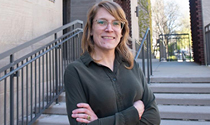|
|
|
|
|
|
| |
Material scientists focus on the science of “stuff”—the new metal alloys, chemical compounds, and versatile plastics of emerging technology. In this issue of µChicago, meet the researchers shaping their ideas into tangible reality. |
|
| |
|
|
|
| |
Enter the “material world” |
|
| |
|
|
|
|
|
| |
| |
|
|
| |
From left: Graduate student Nicholas Boynton; Shrayesh Patel, assistant professor of molecular engineering; and Stuart Rowan, Barry L. MacLean Professor for Molecular Engineering Innovation and Enterprise in the UChicago Pritzker School of Molecular Engineering, show off their pluripotent plastic material. Photography by John Zich. |
|
| |
|
|
|
|
| |
|
|
|
| |
Since 1961 engineers at the University of Chicago’s Materials Research Science and Engineering Center have been merging fundamental science with creativity. The arrival of molecular engineering at UChicago in 2011 brought a new wave of scholars, expanding the center’s focus on developing materials with practical applications and real-world impact. Some recent breakthroughs take inspiration from nature, including pluripotent plastics that can take multiple forms and a soil-like material designed to promote microbial growth. Other projects emphasize climate sustainability through advanced materials for temperature regulation and green energy storage. The center’s interdisciplinary approach drives discoveries that are poised to shape the future. |
|
| |
|
|
|
| |
Enter the “material world” of their work in the Summer/24 issue of the University of Chicago Magazine. |
|
| |
|
|
|
|
|
| |
Materializing tech of the future |
|
| |
|
|
|
| |
|
|
|
| Catalytic craftsmanship: A tin-based catalyst codeveloped by Argonne National Laboratory scientists uses electricity to convert harmful atmospheric CO2 into chemicals like ethanol and acetic acid, which can be repurposed into consumer products. |
|
|
|
| |
|
|
|
|
|
| |
|
|
|
The dipole role: A new imaging technique allows scientists to study antiferroelectric materials at the nanoscale, revealing their unique dipole arrangement and unlocking their potential for energy storage devices and other electronics.
|
|
|
|
| |
|
|
|
|
|
| |
|
|
|
| “The machine is a material”: The Granulobot—a modular robot inspired by natural swarming behavior—can transition between solid and liquid states, potentially leading to soft robotics applications in extreme environments such as outer space or search and rescue operations. |
|
|
|
| |
|
|
|
|
|
|
|
|
|
| |
| |
|
|
| |
Physicist Jung Ho Kim and other staff of beamline 27-ID watch visible monochromatic light for the first time after opening the shutter on June 17. Photography by Jason Creps/Argonne National Laboratory. |
|
| |
|
|
|
|
| |
|
|
|
| |
An upgrade to the Advanced Photon Source at Argonne National Laboratory will generate X-ray beams up to 500 times brighter than before—or hundreds of billions of times brighter than those of a dentist’s or doctor’s machine. These ultrabright beams can penetrate the exterior of batteries, solar cells, and other technologies so scientists can study and improve their efficiency. Building on 30 years of X-ray science at Argonne, the new and improved storage ring is also pioneering the use of multi-bunch swap-out injection to replenish electrons and keep the beam current constant as it circulates. When all 71 experiment stations, or beamlines, enter operation later this year, scientists will begin to conduct their research with an unprecedented ability to explore and understand complex materials. |
|
| |
|
|
|
|
|
|
|
| |
| |
|
|
| |
And now for the weather:
Explore current research into climate change, weather shifts, and new tech that could mitigate their devastating effects.
|
| |
|
|
|
|
|
| |
|
|
|
|
|
| |
| |
Sign up to receive µChicago monthly. |
|
|
|
| |
|
|
|
|





